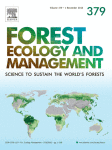Ver ítem
- xmlui.general.dspace_homeCentros Regionales y EEAsCentro Regional Patagonia SurEEA Santa CruzArtículos científicosxmlui.ArtifactBrowser.ItemViewer.trail
- Inicio
- Centros Regionales y EEAs
- Centro Regional Patagonia Sur
- EEA Santa Cruz
- Artículos científicos
- Ver ítem
Carbon accumulation along a stand development sequence of Nothofagus antarctica forests across a gradient in site quality in Southern Patagonia
Resumen
Above- and below-ground C pools were measured in pure even-aged stands of Nothofagus antarctica (Forster f.) Oersted at different ages (5–220 years), crown and site classes in the Patagonian region. Mean tissue C concentration varied from 46.3% in medium sized roots of dominant trees to 56.1% in rotten wood for trees grown in low quality sites. Total C concentration was in the order of: heartwood > rotten wood > sapwood > bark > small branches > coarse
[ver mas...]
Above- and below-ground C pools were measured in pure even-aged stands of Nothofagus antarctica (Forster f.) Oersted at different ages (5–220 years), crown and site classes in the Patagonian region. Mean tissue C concentration varied from 46.3% in medium sized roots of dominant trees to 56.1% in rotten wood for trees grown in low quality sites. Total C concentration was in the order of: heartwood > rotten wood > sapwood > bark > small branches > coarse roots > leaves > medium roots > fine roots. Sigmoid functions were fitted for total C accumulation and C root/shoot ratio of individual trees against age. Total C accumulated by mature dominant trees was six times greater than suppressed trees in the same stands, and total C accumulated by mature dominant trees grown on the best site quality was doubled that of those on the lowest site quality. Crown classes and site quality also affected the moment of maximum C accumulation, e.g. dominant trees growing on the worse site quality sequestered 0.73 kg C tree−1 year−1 at 139 years compared to the best site where 1.44 kg C tree−1 year−1 at 116 years was sequestered. C root/shoot ratio decreased over time from a maximum value of 1.3–2.2 at 5 years to a steady-state asymptote of 0.3–0.7 beyond 60 years of age depending on site quality. Thus, root C accumulation was greater during the regeneration phase and for trees growing on the poorest sites. The equations developed for individual trees have been used to estimate stand C accumulation from forest inventory data. Total stand C content ranged from 128.0 to 350.9 Mg C ha−1, where the soil C pool represented 52–73% of total ecosystem C depending on age and site quality. Proposed equations can be used for practical purposes such as estimating the impact of silvicultural practices (e.g. thinning or silvopastoral systems) on forest C storage or evaluating the development of both above- and below-ground C over the forest life
cycle for different site qualities for accurate quantification of C pools at regional scale.
[Cerrar]

Autor
Peri, Pablo Luis;
Gargaglione, Veronica Beatriz;
Martínez Pastur, Guillermo José;
Lencinas, María Vanessa;
Fuente
Forest Ecology and Management 260 : 229-237. (June 2010)
Fecha
2010-06-25
Editorial
Elsevier
ISSN
0378-1127
Formato
pdf
Tipo de documento
artículo
Palabras Claves
Derechos de acceso
Restringido
 Excepto donde se diga explicitamente, este item se publica bajo la siguiente descripción: Creative Commons Attribution-NonCommercial-ShareAlike 2.5 Unported (CC BY-NC-SA 2.5)
Excepto donde se diga explicitamente, este item se publica bajo la siguiente descripción: Creative Commons Attribution-NonCommercial-ShareAlike 2.5 Unported (CC BY-NC-SA 2.5)

